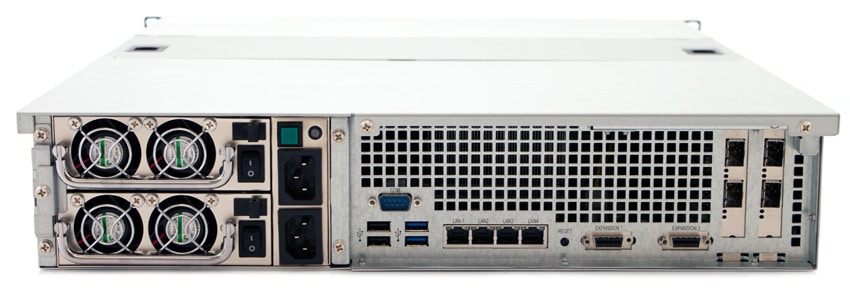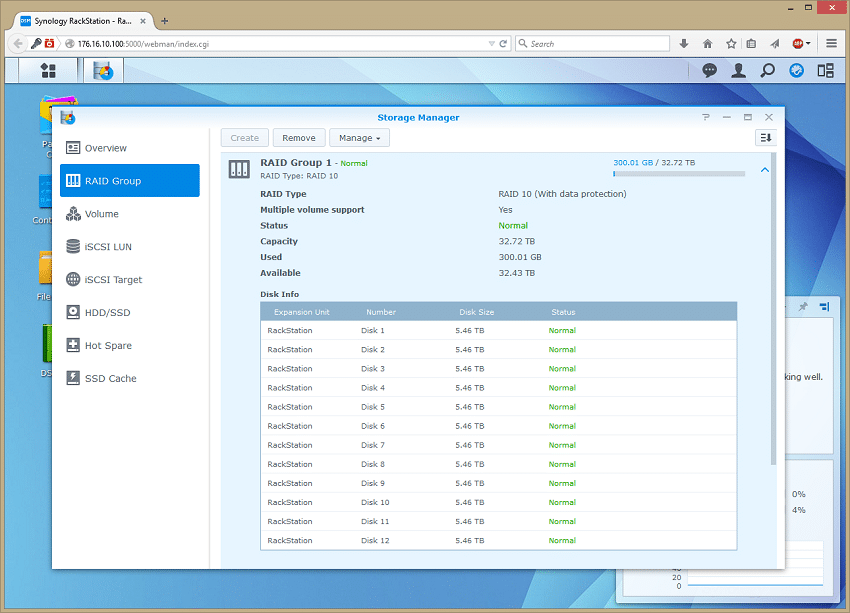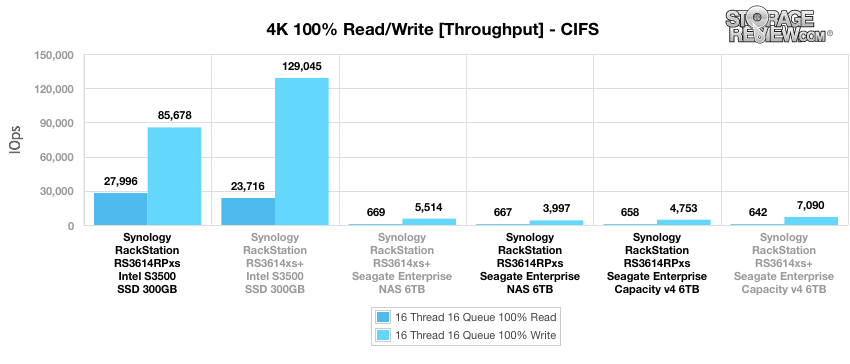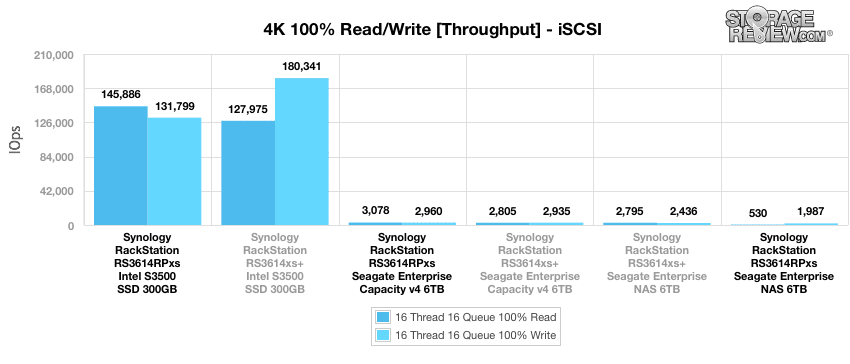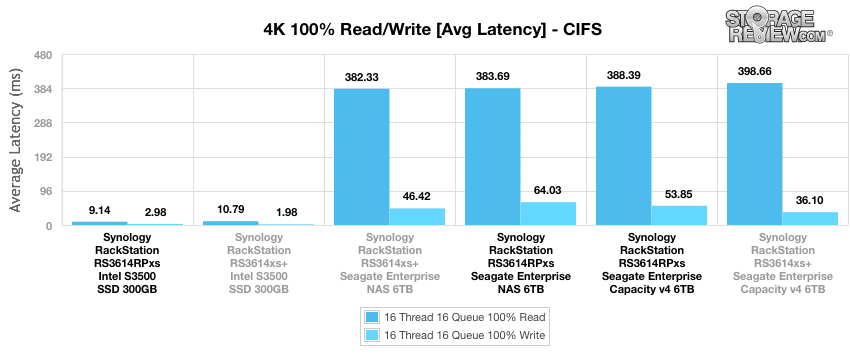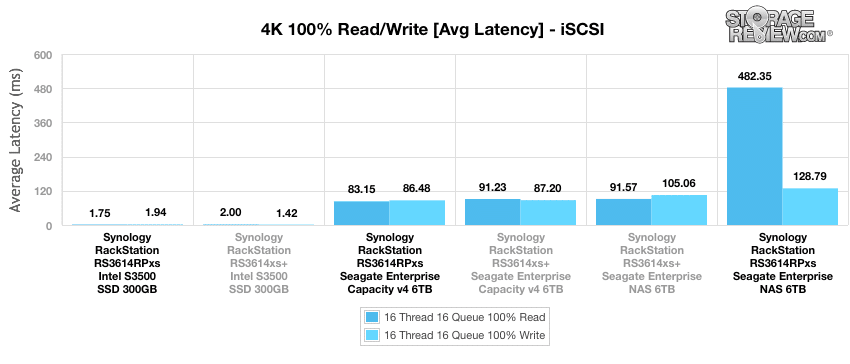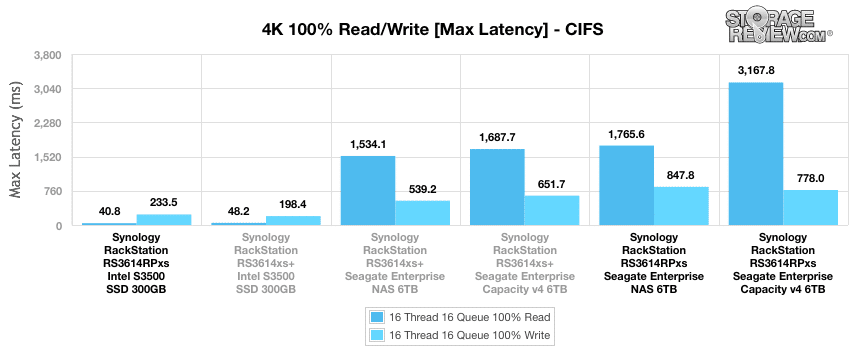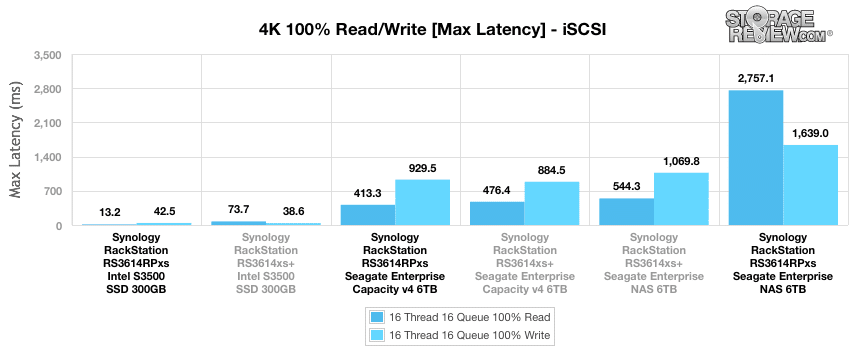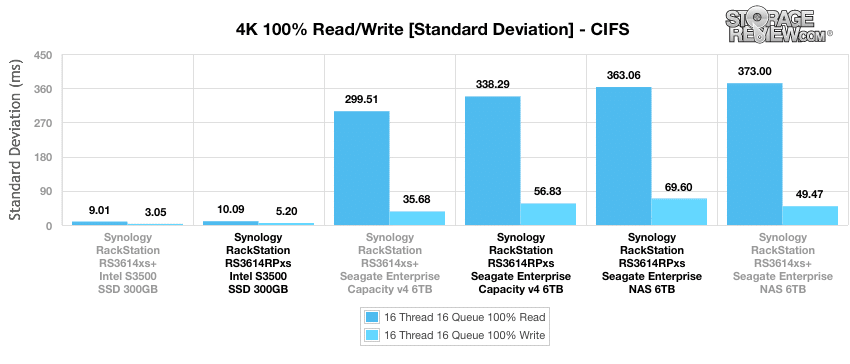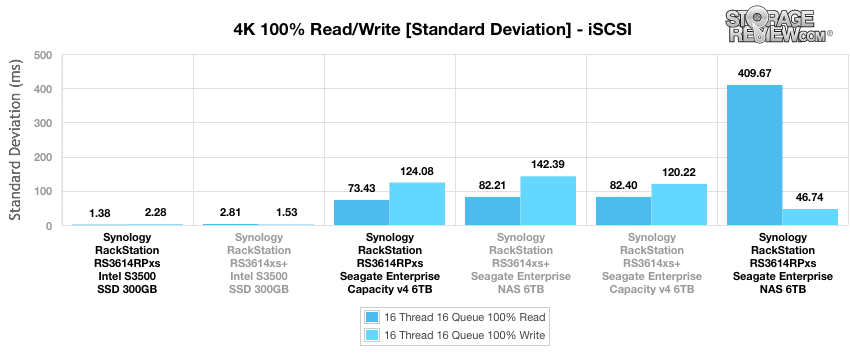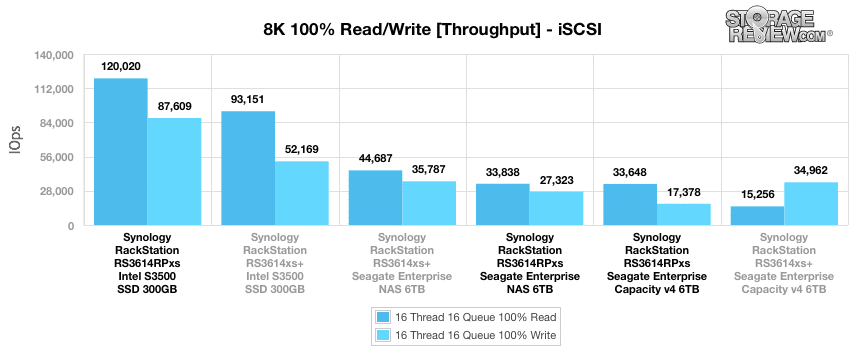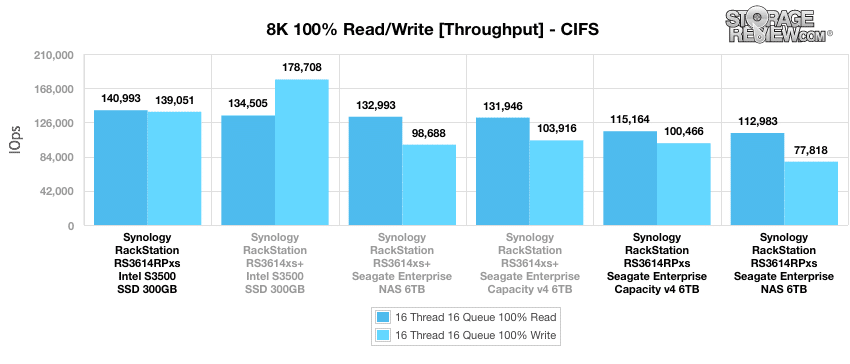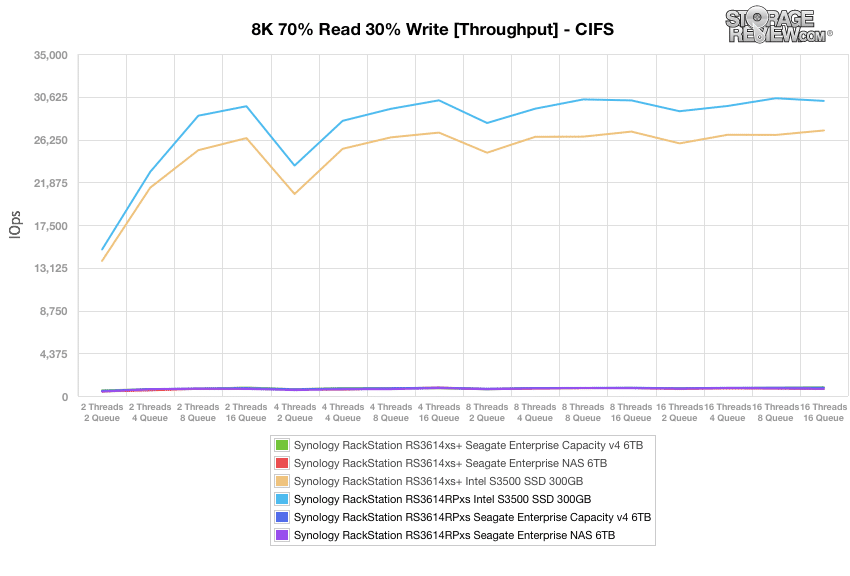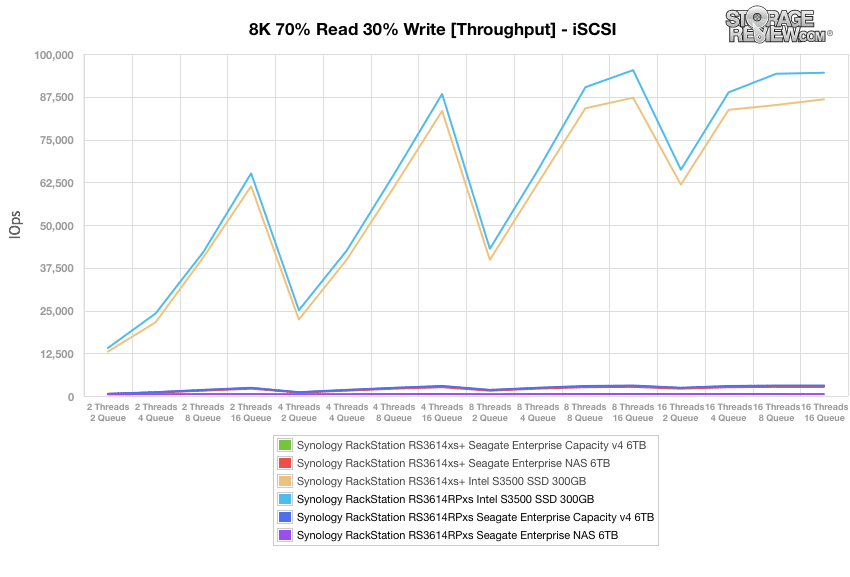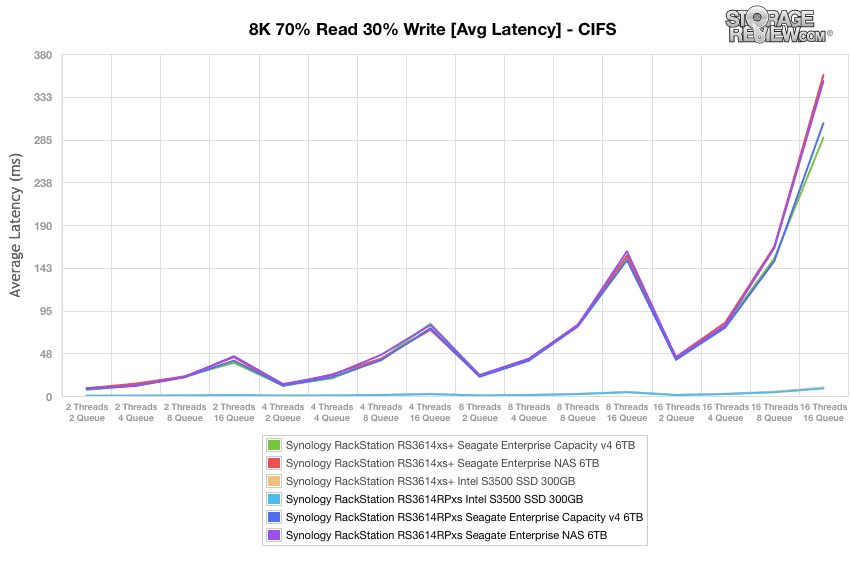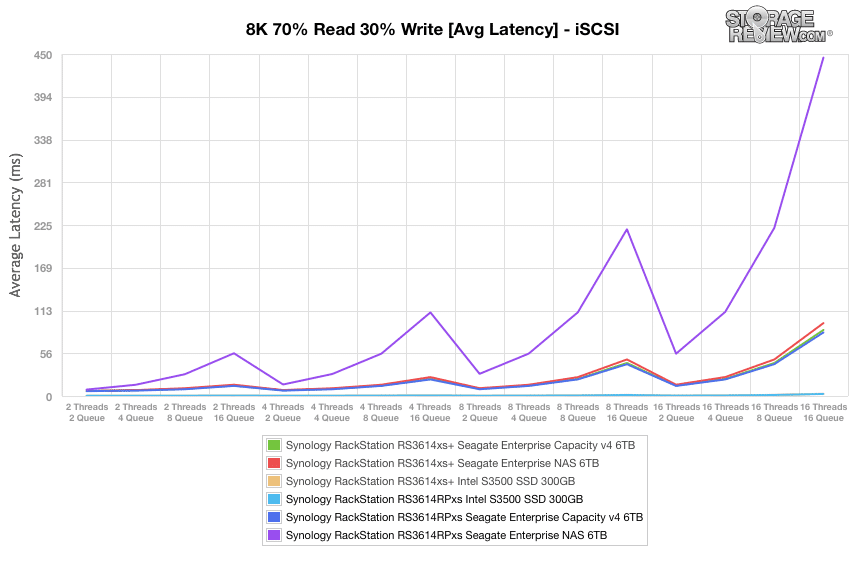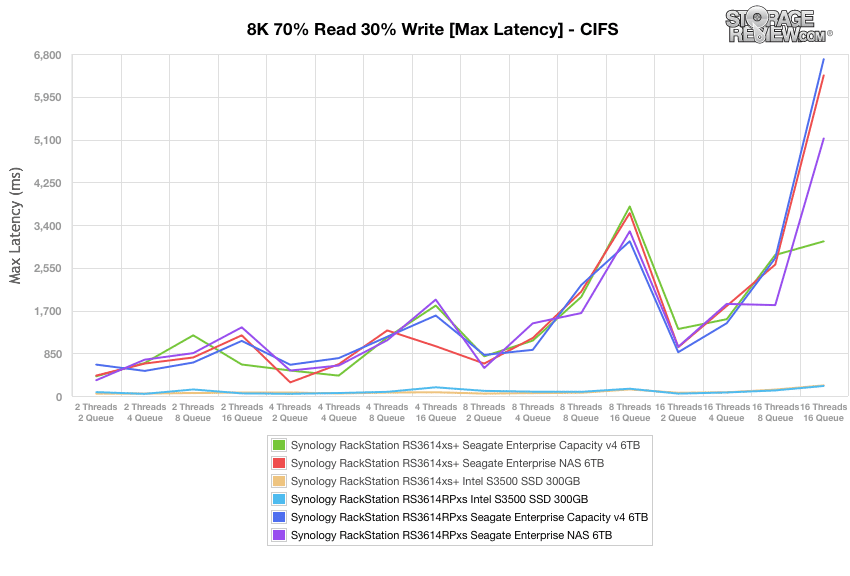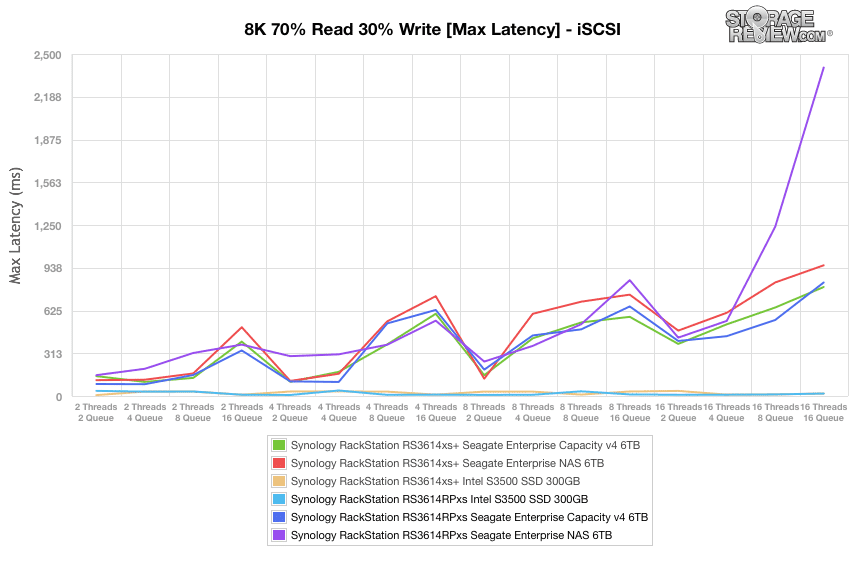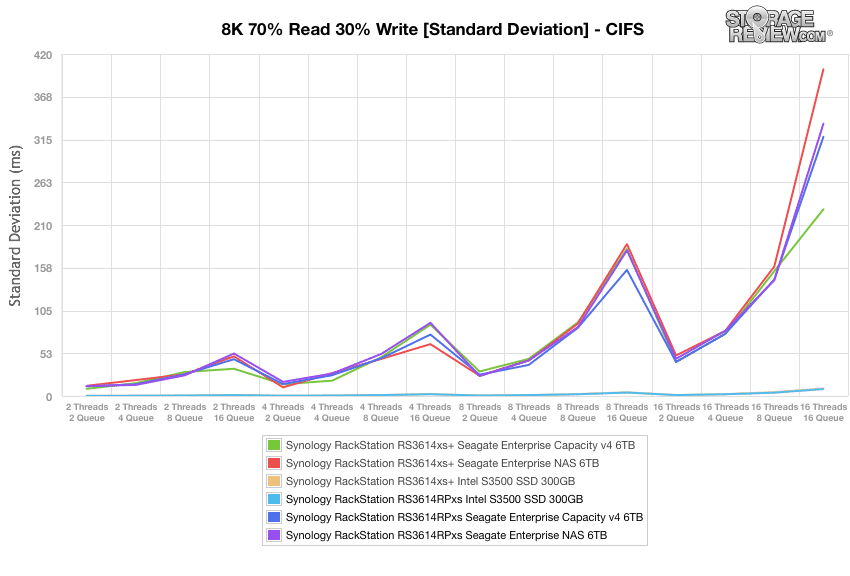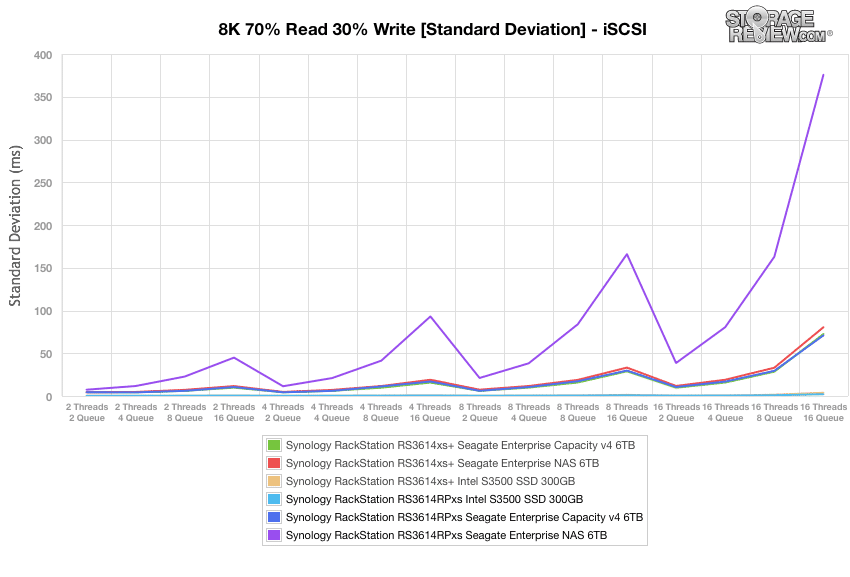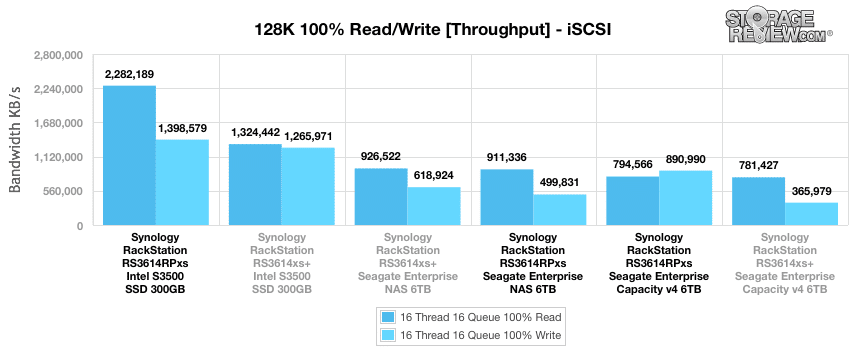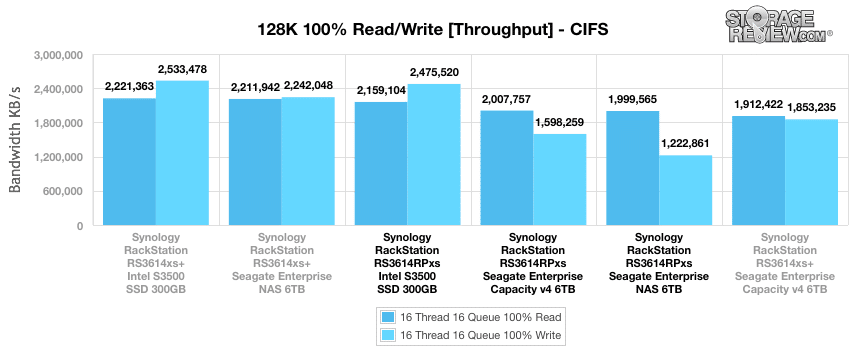
The RS3614RPxs is a network attached storage solution with an emphasis reliability and performance. Its main intent is to centralize data protection, simplify data management, and deploy virtualization solutions, all of which, Synology indicates, can be performed with as little time wasted on setup and maintenance as possible. Synology also offers two versions of this RackStation: the RS3614xs and the RS3614RP, the latter which is equipped with dual power supplies.

We reviewed the Synology RackStation RS3614xs+ model prior to looking at the RS3614xs and though both are very similar in functionality, the key differences between the two include the CPU model, CPU frequency and RAM. While the RS3614xs+ is equipped with Intel Xeon E3-1230 v2 CPU boasting a Quad Core 3.3 GHz and 8GB DDR3 ECC of RAM, the RS3614xs is built with an Intel Core i3-4130 with Dual Core 3.4 GHz and 4GB DDR3 ECC (though both models can be expanded to 32GB of the same brand of RAM). These differences in hardware make it clear that the xs+ model focuses much more on performance, whereas this model is targeted more towards SMB use cases that have an investment in rack infrastructure and want a NAS that’s full-featured but don’t require as much performance. The RS3614xs/RS3614RPxs is quoted to deliver 3,518MB/s throughput and 282,660 IOPS while configured under RAID 5.
Synology RS3614xs and RS3614RPxs NAS come with a 5-year limited warranty. The units carry a street price of around $4,000 diskless.
Synology RackStation RS3614xs Specifications
- CPU Model: INTEL Core i3-4130
- CPU Frequency: Dual Core 3.4 GHz
- Floating Point
- Hardware Encryption Engine (AES-NI)
- Memory:
- System Memory: 4GB DDR3 ECC
- Memory Module Pre-installed: 2 GB X 2
- Total Memory Slots: 4
- Memory Expandable up to: 32 GB (8 GB X 4)
- Drive Bay(s): 12
- Maximum Drive Bays with Expansion Unit: 36
- Compatible Drive Type:
- 3.5″ SATA(III) / SATA(II) HDD
- 2.5″ SATA(III) / SATA(II) HDD
- 2.5″ SATA(III) / SATA(II) SSD
- Maximum Internal Raw Capacity: 72 TB (6 TB HDD X 12) (Capacity may vary by RAID types) (See All Supported HDD)
- Hot Swappable Drive
- External Ports
- USB 2.0 Port: 2
- USB 3.0 Port: 2
- Expansion Port: 2
- Internal Drives: EXT4
- External Drives
- EXT4
- EXT3
- FAT
- NTFS
- HFS+
- Size (Height X Width X Depth):
- 88 mm X 445 mm X 570 mm
- 88 mm X 445 mm X 570 mm (for RP model)
- Weight
- 13.3 kg
- 15.4 kg (for RP model)
- Others:
- RJ-45 1GbE LAN Port: 4 (with Link Aggregation / Failover support)
- Wake on LAN/WAN
- PCIe x8 Slot for Network Card (See more): 2 (white at x8 mode, black at x4 mode)
- System Fan: 80 mm X 80 mm X 4 pcs
- Easy Replacement System Fan
- Wireless Support (dongle)
- Noise Level:
- 40.5 dB(A)
- 42.2 dB(A) (for RP model)
- Power Recovery
- Scheduled Power On/Off
- Power Supply Unit / Adapter: 500W
- 2 X 400W (for RP model)
- AC Input Power Voltage: 100V to 240V AC
- Power Frequency: 50/60 HZ, Single Phase
- Power Consumption:
- 97.42W (Access)
- 57.48W (HDD Hibernation)
- 101.02W (Access, for RP model)
- 62.73W (HDD Hibernation, for RP model)
- Redundant Power Supply (for xs+ and RP model)
- Environment Temperature
- Operating Temperature: 5°C to 35°C (40°F to 95°F)
- Storage Temperature: -20°C to 60°C (-5°F to 140°F)
- Relative Humidity: 5% to 95% RH
- Certification
- FCC Class A
- CE Class A
- BSMI Class A
- Warranty: 5 Years
Design and Build
From a look-and-feel standpoint, the RackStation RS3614xs is visually identical to the plus model, with its 2U rack-mounted form factor and is equipped with 12 front-mounted hot-swappable 3.5-inch bays (both 3.5-inch and 2.5-inch HDDs and SSDs).
In addition to its 12 drive trays, the RS3614xs’s front panel is comprised of several LEDs such as the Status (which Displays the status of the system), Alert (which displays warnings regarding fan or temperature) and Disk (which displays the status of installed drives) indicators. The Power and “Beep off” buttons, the latter which deactivates beep sounds when malfunctions occur, is also located on the front panel.
Moving to the back panel shows a familiar Synology layout. Here, 4x LAN ports, 2x USB 2.0 and 2x 3.0 port, and expansion port are visible. On the left side are four fans that dispose of excessive heat and cools the system. If a fan malfunctions, the RackStation will emit a beeping sound. Our model, the RS3614RPxs, has a redundant power supply. The plus version does not have this option. Also visible is the dual PCIe slots for dual-port 10GbE NIC support as well as expander ports.
Inside the chassis, reside Dual Core 3.4 GHz processor with 4GB of DDR3 ECC RAM (expandable up to 32GB).
Management
The RS3614xs is managed by Synology’s DiskStation Manager (DSM), Synology’s intuitive web-based operating system found on every DiskStation and RackStation. DSM offers several Synology and third party applications and features designed specifically for businesses.
The RS3614xs is compatible with the latest version of DSM (5.1), which has introduced peerless bidirectional sync, catering to businesses that need to share pools of data for collaborative work. In addition, files, file-types, and selected folders can be synced with another RackStation without intermediating hardware and businesses can now share common assets with Cloud Station, which is included in the DSM package. Users can download and install add-ons through the Package Center.
Testing Background and Comparables
We will be testing the Synology RackStation RS3614xs with the following hard drives in iSCSI block-level and CIFS file-level tests:
This array was benchmarked with our Lenovo ThinkServer RD630 Testbed:
- 2 x Intel Xeon E5-2690 (2.9GHz, 20MB Cache, 8-cores)
- Intel C602 Chipset
- Memory – 16GB (2 x 8GB) 1333Mhz DDR3 Registered RDIMMs
- Windows Server 2012 Standard
- Boot SSD: 100GB Micron RealSSD P400e
- Mellanox ConnectX-3 dual-port 10GbE NIC
Mellanox SX1036 10/40Gb Ethernet Switch and Hardware
- 36x 40GbE Ports (Up to 64x 10GbE Ports)
- QSFP splitter cables 40GbE to 4x10GbE
Enterprise Synthetic Workload Analysis
Our enterprise benchmark process preconditions each device into steady-state with the same workload the device will be tested with under a heavy load of 16 threads with an outstanding queue of 16 per thread, and then tested in set intervals in multiple thread/queue depth profiles to show performance under light and heavy usage. Since many shared storage platforms reach their rated performance level very quickly, we only graph out the main sections of each test.
Preconditioning and Primary Steady-State Tests:
- Throughput (Read+Write IOPS Aggregate)
- Average Latency (Read+Write Latency Averaged Together)
- Max Latency (Peak Read or Write Latency)
- Latency Standard Deviation (Read+Write Standard Deviation Averaged Together)
Our Enterprise Synthetic Workload Analysis includes four profiles based on real-world tasks. These profiles have been developed to make it easier to compare to our past benchmarks as well as widely-published values such as max 4k read and write speed and 8k 70/30, which is commonly used for enterprise drives.
- 4k
- 100% Read or 100% Write
- 100% 4k
- 8k 70/30
- 70% Read, 30% Write
- 100% 8k
- 8k (Sequential)
- 100% Read or 100% Write
- 100% 8k
- 128k (Sequential)
- 100% Read or 100% Write
- 100% 128k
In the first of our enterprise workloads, we measured a long sample of random 4k performance with 100% write and 100% read activity using the CIFS protocol. The RS3614xs showed its best performance when populated with the Intel S3500 SSDs, which measured 85,678 IOPS write and 27,996 IOPS read, the latter which recorded results better than the plus model. The Seagate Enterprise NAS and Enterprise Capacity v4 showed 658/667 IOPS read and 4,753/3,997 IOPS write.
As was the case with plus model, results showed a massive gain in read throughput when measuring block-level iSCSI performance of the RS3614xs, particularly with the Intel S3500 (145,886 IOPS read, 131,799 IOPS write) and Seagate Enterprise Capacity v4 (3,078 IOPS read, 2,960 IOPS write) SSDs.
Next, we are looking at the latency segment with a load of 16T/16Q. In our CIFS file-level test, the RS3614xs showed great performance when populated with the Intel S3500 SSDs at 2.984ms write, 9.142ms read. The Seagate Enterprise Capacity v4 offered 388.39ms read and 53.85ms write, while the Seagate Enterprise NAS posted 383.69ms read and 64.03ms write.
The iSCSI block-level test for the same benchmark showed great results as well with the Intel SSDs, posting only 1.75ms read and 1.94ms write in average latency. The Seagate Enterprise NAS measured 482.35ms read and 128.79ms write while the Seagate Enterprise Capacity v4 offered 83.15ms read 86.48ms write.
In our maximum 4k latency results for CIFS file-level benchmark, the RS3614xs showed 40.847ms read 233.47ms write performance when populated with the Intel 3500 SSDs, the former which was better than the plus model. The Seagate Enterprise NAS scored 1,765.6ms read and 847.81ms write, while the Seagate Enterprise Capacity v4 posted 3,167.8ms read and 778.05ms write
In iSCSI of the same benchmark, the Intel S3500 posted only 13.17ms read and 42.54ms write in maximum latency. The Seagate Enterprise Capacity v4 showed 413.33ms read and 929.51ms write while the Seagate Enterprise NAS posted 2,757.1 read and 1,639ms write.
When charting the standard deviation for the 4k latency, it will show us how consistent the RS3614xs’s latency results were within each of the tested categories. Using the CIFS file-level test, the Intel S3500 SSDs showed 10.09ms read 5.2ms write. When populated with the Seagate Enterprise NAS drives, the RS3614xs showed 363.06ms read and 69.60ms write. The Seagate Enterprise Capacity v4 posted 338.292 read and 56.825 write.
Our iSCSI block-level test showed, the RS3614xs again showed great performance when populated with Intel S3500 SSDs with1.38ms read and 2.28ms write. The Seagate Enterprise NAS posted 409.667ms read, 46.74ms write, while the Seagate Enterprise Capacity v4 scored 73.426ms read, 124.08ms write.
In our next set of benchmarks, we measured 8k sequential speeds. Here, our iSCSI block-level test showed great results, with the Intel SSDs posting an impressive 120,020 IOPS read 87,609 IOPS write. When using the Seagate HDDs, the RS3614xs recorded 33,838 IOPS read and 27,323 write (Seagate Enterprise NAS) and 27,323 IOPS read and 33,838 IOPS write (Seagate Enterprise Capacity v4).
Performance was greatly improved when using the CIFS file-level test. When populated with the Intel drives, the RS3614xs posted 140,993 IOPS read and 139, 051 IOPS write, while the Seagate drives had exponentially better performance compared to iSCSI.
The next four charts are based on a protocol consisting of 70% read operations and 30% write operations with an 8k transfer size. The workload is then varied from 2 threads and a queue depth of 2 up to 16 threads and 16 queue. During our CIFS file-level test, the 8k 70/30 benchmark posted very impressive performance when using the Intel drives, reaching 30K IOPS by 16 Threads 16 Queue. The Seagate Enterprise NAS posted 843 IOPS while the Seagate Enterprise Capacity v4 recorded 729 IOPS.
During our iSCSI tests, all drives performed at a much higher performance level inside the RS3614xs. Here, the Intel S3500 drives almost reached 95,000 IOPS by 16T/16Q.
When looking at average latency with the CIFS block-level test, results were higher in latency for the Intel 3500 (8.47ms) and Seagate Enterprise Capacity (303.21ms) drives by 16T/16Q.
In our average latency test (iSCSI), the RS3614xs performed very well when populated with the Intel 3500 SSDs, with an average latency of only 2.7ms by 16T/16Q. The Seagate Enterprise Capacity v4 recorded 83.62ms at 16T/16Q, while the Seagate Enterprise NAS showed 445.28ms.
We measure maximum latency because it can sometimes reveal issues that are not always obvious in our average latency results. During our CIFS block-level test, results were higher overall. The Intel drive showed a max latency of 199.51ms while the Seagate Enterprise NAS posted 5,120.5ms and the Seagate Enterprise Capacity v4 reached 6,699.49ms. All highest values were recorded at 16 Threads 16 Queue.
In iSCSI, performance results for the Intel drives posted a maximum latency of 40.13ms, which occurred at 4 Threads 4 Queue. Both Seagate drives had their highest latency spike occur at the end of the test.
Our standard deviation results for latency for the RS3614xs during our 8k 70/30 CIFS benchmark show 8.53ms when populated with the Intel 3500 SSDs by 16T16Q. The Seagate Enterprise Capacity v4 posted 318.35ms while the Seagate Enterprise NAS recorded 334.36ms by 16T16Q.
During our block-level iSCSI test of the same benchmark, we recorded a 16T16Q standard deviation from the Intel S3500 SSD (2.08ms), Seagate Enterprise NAS 6TB (375.64ms), and Seagate Enterprise Capacity v4 (70.88ms).
The final synthetic benchmark utilizes much larger 128k transfer sizes with sequential 100% read and 100% write operations. Using iSCSI, the Intel S3500 SSD showed read activity at 2.28MB/s and write activity at 1.40MB/s. The HDD configurations inside the RS3614xs boasted 911,336KB/s read and 499,831KB/s write (Seagate Enterprise NAS) and 794,566KB/s read and 890,990KB/s write (Seagate Enterprise Capacity v4).
The CIFS test showed massive gains in both read and write speeds for the HDD configuration, as the Seagate HDDs posted read activity almost on par with the SSD comparable.
Conclusion
Synology’s RackStation RS3614xs is a flexible NAS that offers SMBs and branch/remote offices with reliability and performance while simplifying data management and deployment. When the 12 front-mounted hot-swappable 3.5-inch bays are combined with the RX1214/RX1214RP expansion shelf, the RS3614xs can handle up to 36 drives, giving it the ability scale up to 216TB of raw capacity with HDDs. RackStations also support SSD volumes and can leverage SSDs as a cache. Additionally, the RackStation is equipped with dual PCIe expansion slots that support dual-port 10GbE NICs for even more throughput.
In order to measure the performance of the RS3614xs, we set up the RackStation in an all-flash SSD configuration (Intel S3500 SSD) as well as two HDD configurations using the Seagate Enterprise NAS HDDs and a 4th generation Seagate Enterprise Capacity HDDs. When looking at the 4k results, the RS3614xs showed some impressive performance, even boasting superior read throughput than the plus model (27,996 IOPS vs 23,716 IOPS from the plus model). This was an ongoing trend during the entirety of our 4K read scenarios, though the RS3614xs+ had better write performance. These results were mirrored during our 8k 100% read/write throughput benchmarks, in which the RS3614xs surpassed 140K in throughout during our CIFS test. When looking at the 8K mixed workload tests (70% read, 30% write), we saw strong performance once again, reaching almost 95K IOPS from four iSCSI LUNs.
It’s quite obvious that the Synology RS3614xs outperformed our expectations, and as a result, provides businesses with a ton of flexibility in its small 2U rack form factor. Its DSM software management is also incredibly easy to deploy and use and provides users with enough functionality to satisfy a broad range of use cases. In addition, its support for SSDs and 10GbE, gives users more than enough power to excel in heavy workloads. The RS3614xs is definitely a worthy addition to Synology’s portfolio of rackmount NAS.
Pros
- Excellent performance (out performed the plus model in read activity during many of our benchmarks)
- In-depth feature set
- DSM is robust and easy to use
Cons
- No SAS support
Bottom Line
The Synology RackStation RS3614RPxs is an impressive 2U rack-mount NAS built for SMB businesses looking for both reliability and performance, with budget in mind. Offered with a redundant PSU option, Synology’s new RackStation also provides businesses with an NAS solution that is easy to set up and manage as well as support for SSDs and optional 10GbE.
Synology RackStation RS3614RPxs at Amazon

